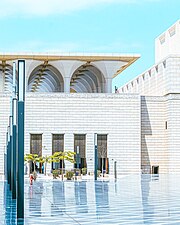|
Djamaa el Djazaïr
Djamaa el Djazaïr (Arabic: جامع الجزائر), also known as the Great Mosque of Algiers (French: Grande mosquée d'Alger), is a large mosque located in Algiers, Algeria. Opened in April 2019, it houses the world's tallest minaret and is the third-largest mosque in the world after the Great Mosque of Mecca and Al-Masjid an-Nabawi of Medina in Saudi Arabia.[2][3][4] The mosque features a prayer hall (salat) with an area of 22,000 m2 (240,000 sq ft),[5] capable of accommodating 120,000 worshippers. The central nave of this hall is surrounded by colonnades, with the mihrab located to the east, made of white marble. The hall is topped by a dome with a diameter of 50 m (160 ft), reaching a height of 70 m (230 ft). HistoryThe project to provide the capital Algiers with a grand mosque was presented as an initiative of the former Algerian president Abdelaziz Bouteflika to mark his presidential mandates.[6] The German consortium that designed Djamaâ El Djazaïr consisted of two architectural firms named "KSP Jürgen Engel Architekten"[7] and "Krebs und Kiefer"[8] until 2016. This German consortium won the international architectural competition for the project in January 2008, and the contract was signed in July 2008 for the execution in the presence of the German Chancellor Angela Merkel. The commission included general design and execution studies for all disciplines, as well as monitoring and control of the construction works of Djamaâ El Djazaïr. The design team consisted of over 100 architects and engineers. In 2007, the engineering and construction company Dessau-Soprin obtained the project management contract.[9] The Chinese company China State Construction Engineering (CSCEC) was tasked with the construction of the Mosque El Djazaïr. The first concrete foundation casting operations began on 16 August 2012, after a launching ceremony. The construction was expected to create 17,000 jobs, with 10,000 workers from China and 7,000 from Algeria.[10] The French engineering firm Socotec[11] later joined the project. The French consulting firm Egis oversaw the construction from February 2016 to verify the additional plans provided by CSCEC. Djamaâ El Djazaïr was financed by the Algerian state with an initial budget of 1 billion euros (approximately 1.5 billion dollars). The official cost of the mosque was 898 million euros or nearly 2 billion dollars.[12] The construction lasted for seven years.[13] The construction was criticized for its monumental aspect and its expensive costs.[14] Despite some criticisms, the inauguration and the first prayer inside the mosque attracted a large crowd of Algerian faithful.[15] ArchitectureThe architecture of the mosque is of square geometry combining modern and traditional styles. It evokes the oldest type of mosque, the mosque with colonnades which open upwards like a flower while providing space for technical conduits. The mosque sits on a site covering 27.75 hectares (68.6 acres)[16] and overlooks the Mediterranean Sea. The prayer hall has a capacity of 37,000 worshippers, while the structure including the compound can house up to 120,000 worshippers and has parking space for 7,000 cars. The complex also houses a Quran school, a park, a library, staff housing area, a fire station, a museum of Islamic art, and a research center on the history of Algeria.[17] The mosque also has a 265 m (869 ft) tall minaret, the tallest in the world, which due to containing office space also meets the definition of a building, and was the tallest building in Africa until overtaken in 2024 by the Iconic Tower in Egypt's New Administrative Capital.[18] It also houses an observation deck atop the minaret, which has 37 floors. The mosque is designed to withstand an earthquake of magnitude 9.0 and the structure has been specially processed to resist corrosion. The main prayer hall has 618 octagonal columns serving as support pillars and 6 km (3.7 mi) of calligraphic writing engraved with a laser system. The dome of the prayer hall has a diameter of 50 m (160 ft) and rises to a height of 70 m (230 ft).[19] AccessRoadwaysSeveral roads and other means of access lead to Djamaâ El Djazaïr from the Algiers suburbs. It can be accessed by car via the northern ring road of Algiers, taking the Mohammadia/Grande Mosque exit. Public TransportThe Algiers tramway provides access via the Pont El Harrach and Bellevue stations, located within a 10-minute walking distance of the Mosque. The ETUSA bus line B19 passes near the Mosque, which can connect it to the metro line M1 or to the Algiers commuter rail network via the Caroubier station. It will soon be possible to access the mosque by boat via the Algiers Marina project, north of the mosque, where a maritime terminal will be built. The mosque also has a helipad. Gallery
See also
References
External links
|
||||||||||||||||||||||||||||||||||||||||||||||||||||||





